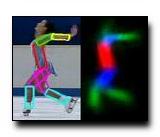
An open vision problem is to automatically track the articulations of people from a video sequence. This problem is difficult because one needs to determine both the number of people in each frame and estimate their configurations. But finding people and localizing their limbs is hard because people can move fast and unpredictably, can appear in a variety of poses and clothes, and are often surrounded by limb-like clutter.
We develop a completely automatic system that works in two stages; it first builds a model of appearance of each person in a video, and then, it tracks by detecting those models in each frame (``tracking by model-building and detection''). We develop two algorithms that build models; one bottom-up approach groups together candidate body parts found throughout a sequence. We also describe a top-down approach that automatically builds people-models by detecting convenient key poses within a sequence. We finally show that building a discriminative model of appearance is quite helpful since it exploits structure in a background (without background-subtraction).
We demonstrate the resulting tracker on hundreds of thousands of frames of unscripted indoor and outdoor activity, a feature-length film (`Run Lola Run'), and legacy sports footage (from the 2002 World Series and 1998 Winter Olympics). Experiments suggest that our system can (a) count distinct individuals; (b) identify and track them; (c) recover when it loses track, for example, if individuals are occluded or briefly leave the view; (d) identify body configuration accurately; and (e) is not dependent on particular models of human motion.
Download: pdf
Text Reference
Deva Ramanan, D.A. Forsyth, and Andrew Zisserman.
Tracking people by learning their appearance.
PAMI, 29(1):65–81, January 2007.
BibTeX Reference
@article{RamananFZ_PAMI_2007,
AUTHOR = "Ramanan, Deva and Forsyth, D.A. and Zisserman, Andrew",
TAG = "people",
TITLE = "Tracking People by Learning Their Appearance",
JOURNAL = "PAMI",
VOLUME = "29",
YEAR = "2007",
NUMBER = "1",
MONTH = "January",
PAGES = "65-81",
BIBSOURCE = "http://www.visionbib.com/bibliography/motion-f743.html#TT53852"
}
